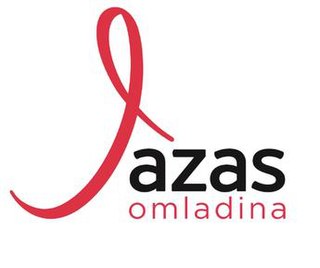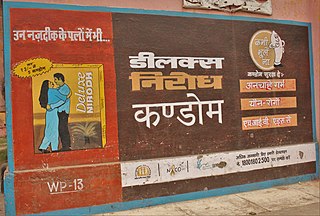
A condom is a sheath-shaped barrier device used during sexual intercourse to reduce the probability of pregnancy or a sexually transmitted infection (STI). There are both external (male) and internal (female) condoms.

Mechai Viravaidya is a former politician and activist in Thailand known for promoting condoms, family planning, and AIDS awareness. Since the 1970s, Mechai has been affectionately called "Mr. Condom", and condoms are often referred to as "mechais" in Thailand. From the time that he began his work, the average number of children in Thai families has decreased from 7 to 1.5. He has been credited with leading efforts that improved the lives of millions of people.

The first AIDS case identified in Brazil was in 1982. Infection rates climbed exponentially throughout the 1980s, and in 1990 the World Bank famously predicted 1,200,000 cases by 2000, approximately double the actual number that was later reported by the Brazilian Ministry of Health and most international organizations. South and Southeast have 75% or more of this infection. The Northeast has 33% of the population but only 10% of AIDS.

HIV/AIDS is one of the most serious health concerns in South Africa. The country has the highest number of people afflicted with HIV of any country, and the fourth-highest adult HIV prevalence rate, according to the 2019 United Nations statistics.

An internal condom is a barrier device that is used during sexual intercourse as a barrier contraceptive to reduce the probability of pregnancy or sexually transmitted infection (STI). It is inserted in the vagina or anus before intercourse to reduce the risk of exposure to semen or other body fluids. The internal condom was invented by Danish MD Lasse Hessel in 1990 and approved by the FDA for sale in the US in 1993.

Adam & Eve is an American company that sells adult products through e-commerce. In 2004, it was the largest mail order distributor of sex toys, condoms, and erotica in the United States. Its parent company, PHE Inc., is the largest private employer in Hillsborough, North Carolina, where its headquarters are located. The company funds non-profit social marketing organizations that address issues such as population growth, disease control, and sex education in developing countries.
The very high rate of human immunodeficiency virus infection experienced in Uganda during the 1980s and early 1990s created an urgent need for people to know their HIV status. The only option available to them was offered by the National Blood Transfusion Service, which carries out routine HIV tests on all the blood that is donated for transfusion purposes. The great need for testing and counseling resulted in a group of local non-governmental organizations such as The AIDS Support Organisation, Uganda Red Cross, Nsambya Home Care, the National Blood Bank, the Uganda Virus Research Institute together with the Ministry of Health establishing the AIDS Information Centre in 1990. This organization worked to provide HIV testing and counseling services with the knowledge and consent of the client involved.
The history of condoms goes back at least several centuries, and perhaps beyond. For most of their history, condoms have been used both as a method of birth control, and as a protective measure against sexually transmitted infections such as syphilis, gonorrhea, chlamydia, hepatitis B and more recently HIV/AIDS. Condoms have been made from a variety of materials; prior to the 19th century, chemically treated linen and animal tissue are the best documented varieties. Rubber condoms gained popularity in the mid-19th century, and in the early 20th century major advances were made in manufacturing techniques. Prior to the introduction of the combined oral contraceptive pill, condoms were the most popular birth control method in the Western world. In the second half of the 20th century, the low cost of condoms contributed to their importance in family planning programs throughout the developing world. Condoms have also become increasingly important in efforts to fight the AIDS pandemic.
Angola has a large HIV/AIDS infected population, however, it has one of the lowest prevalence rates in the Southern Africa zone. The status of the HIV/AIDS epidemic in Angola is expected to change within the near future due to several forms of behavioral, cultural, and economic characteristics within the country such as lack of knowledge and education, low levels of condom use, the frequency of sex and number of sex partners, economic disparities and migration. There is a significant amount of work being done in Angola to combat the epidemic, but most aid is coming from outside of the country.
Infection rates of HIV/AIDS in Mali are estimated to be under 2%, which is relatively low compared to other parts of Africa, although the infection rate is higher among women of childbearing age. However, this figure is most likely deceptive; the problem in attempting to estimate infection rates is that voluntary testing is rare. Women who give birth in a hospital are automatically tested, but others in the general population rarely present themselves for testing. National education campaigns have targeted the general population since the late 1990s, as government and international organizations are concerned that Malians may be vulnerable to the spread of the pandemic. Since 2002, the Supreme National Council for AIDS (HCNLS) has coordinated educational campaigns around sexual activity and condom use to stem HIV infection. Condom use remains low by international standards.

As of 2012, approximately 1,100,000 people in Malawi are HIV-positive, which represents 10.8% of the country's population. Because the Malawian government was initially slow to respond to the epidemic under the leadership of Hastings Banda (1966–1994), the prevalence of HIV/AIDS increased drastically between 1985, when the disease was first identified in Malawi, and 1993, when HIV prevalence rates were estimated to be as high as 30% among pregnant women. The Malawian food crisis in 2002 resulted, at least in part, from a loss of agricultural productivity due to the prevalence of HIV/AIDS. Various degrees of government involvement under the leadership of Bakili Muluzi (1994–2004) and Bingu wa Mutharika (2004–2012) resulted in a gradual decline in HIV prevalence, and, in 2003, many people living in Malawi gained access to antiretroviral therapy. Condoms have become more widely available to the public through non-governmental organizations, and more Malawians are taking advantage of HIV testing services.
HIV/AIDS in El Salvador has a less than 1 percent prevalence of the adult population reported to be HIV-positive. El Salvador therefore is a low-HIV-prevalence country. The virus remains a significant threat in high-risk communities, such as commercial sex workers (CSWs) and men who have sex with men (MSM).
The Catholic Church is a major provider of medical care to HIV/AIDS patients. Much of its work takes place in developing countries, although it has also had a presence in the global north. Its opposition to condoms, despite their effectiveness in preventing the spread of HIV, has invited criticism from public health officials and anti-AIDS activists.
The relationship between religion and HIV/AIDS has been an ongoing one, since the advent of the pandemic. Many faith communities have participated in raising awareness about HIV/AIDS, offering free treatment, as well as promoting HIV/AIDS testing and preventative measures. Christian denominations, such as Lutheranism and Methodism, have advocated for the observance of World AIDS Day to educate their congregations about the disease. Some Churches run voluntary blood testing camps and counselling centers to diagnose and help those affected by HIV/AIDS.

Yugoslav Youth Association Against AIDS – Youth of JAZAS is non-profit, humanitarian organization committed to HIV prevention and support to the people living with HIV. Ever since its establishment in 1994, it has continuously been implementing projects of peer education, social and psychological support, protection of human rights, promoting voluntary activism, distribution of condoms etc.
Initial events and trends in the discussion of HIV and AIDS in mass media contributed to the stigma and discrimination against those affected with the disease. Later discussion, sometimes led by HIV+ individuals themselves, moved toward advocacy and education on disease prevention and management. The UNESCO report on Journalism Education says, "Well researched television content can create public awareness about HIV prevention, treatment, care and support can potentially influence the development and implementation of relevant policies."
The Population and Community Development Association (PDA) is a non-governmental organization in Thailand. Its goal is to reduce poverty through both development initiatives and family planning programs. Originally called the Community-Based Family Planning Service, it was founded by Mechai Viravaidya in 1974. In the early 1970s, Viravaidya was the Minister of Industry but became frustrated with the government's inability to implement a national family planning policy. In his work with the government, he identified a direct correlation between Thailand's poverty and population growth. His immediate concern was the high population growth rate of 3.2%, which equated to approximately seven children per family. The population growth rate was an increasing concern for Thailand and Mechai Viravaidya because high growth rates restricted Thailand's ability to provide for its entire population and improve living conditions. By 2011, Thailand's population growth rate was only 0.566%. A sharp reduction in poverty has followed upon the reduction in family size, a reduction which can in significant part be attributed to the influence and programs of the PDA.

Shuga, also known as MTV Shuga, is a television drama series that was first aired in November 2009 on MTV Base as part of an initiative dubbed "MTV Staying Alive Ignite!". Its first two seasons were commissioned by MTV Networks Africa in association with The MTV Staying Alive Foundation, PEPFAR, the Partnership for an HIV-Free Generation (HFG) and the Government of Kenya, as part of a multimedia campaign to spread the message about responsible sexual behaviour and tolerance. The term Shuga is derived from the pronunciation of "Sugar" in Kenyan English.

Nirodh is the first condom brand produced in India. Introduced in 1968, the condom is credited with the success of the family planning and birth control campaign in the country. From 2.40% in 1964, India's population growth rate dropped to 1.80% by 2005 with the help of Nirodh. As of 2015, population growth rate of India was 1.26%.

Julio and Marisol was a bilingual (English/Spanish) public-service advertising campaign that ran in the New York City Subway, promoting condom use to prevent AIDS. The well-known catchphrase was a line from the first installment, in which Marisol sobs, "I love you, but not enough to die for you".










